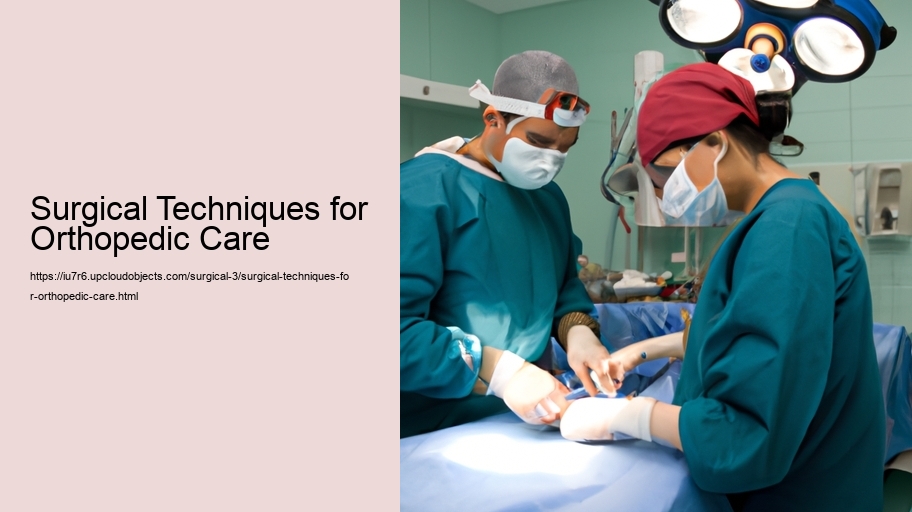Surgical Techniques for Orthopedic Care: An Exploration of Innovation and Precision
Orthopedic care has evolved tremendously over the years, with surgical techniques becoming more sophisticated, less invasive, and more focused on patient-specific treatments. These advancements have significantly improved the outcomes for patients suffering from a wide range of musculoskeletal conditions. In this essay, we will delve into the cutting-edge surgical techniques that are at the forefront of orthopedic care, examining how they have revolutionized treatment and what they mean for the future of patient care.
One of the most significant developments in orthopedic surgery is the advent of arthroscopic techniques. Arthroscopy allows surgeons to inspect, diagnose, and treat problems inside a joint using a small camera known as an arthroscope. This minimally invasive method involves making small incisions through which the arthroscope and surgical instruments are inserted. The camera projects images onto a screen, guiding the surgeon's movements. This technique reduces recovery time, pain, and the risk of infection, compared to traditional open surgery.
Joint replacement, or arthroplasty, is another area where surgical techniques have seen remarkable improvements. Total hip and knee replacements are now among the most successful operations in medicine, giving patients new leases on life. The precision with which these procedures are carried out has been enhanced by computer-assisted surgery (CAS) and robotic-assisted surgery. These technologies provide real-time imaging and allow for more accurate alignment and placement of prosthetic components, which can lead to better joint function and longevity of the implant.
The use of 3D printing in orthopedics is another groundbreaking advancement. Surgeons can now create patient-specific implants and surgical instruments based on the patient's own anatomy. This customization can lead to better fitting implants, reduced surgery times, and improved outcomes. Furthermore, biodegradable scaffolds can be 3D printed to support the repair of complex bone fractures, gradually dissolving as the natural bone heals.
Spinal surgery has also greatly benefited from technological advancements and innovative techniques. Surgeons now use minimally invasive methods to treat various spinal disorders, causing less disruption to the muscles and tissues surrounding the spine. These approaches can reduce post-operative discomfort and speed up the recovery process. Additionally, spinal fusion techniques have advanced to include the use of bone morphogenetic proteins (BMPs), which stimulate bone growth and fusion, reducing the need for bone grafts from the patient's pelvis.
In the realm of sports medicine, advancements in surgical techniques have dramatically improved the prognosis for athletes with ligament injuries, such as anterior cruciate ligament (ACL) tears. Reconstruction of the ACL has become a more refined procedure, with options for different types of grafts and fixation devices. Surgeons can tailor the reconstruction to the needs of the patient, taking into consideration their activity level and the demands of their sport.
Pediatric orthopedic surgery has also seen considerable progress. Techniques have been developed to correct congenital deformities and growth-related disorders with greater precision and less trauma to the growing tissues. Growth modulation, for instance, uses minimally invasive methods to correct angular deformities in children's limbs by altering the growth pattern of the bone.
Finally, the field of orthopedic oncology has benefitted from advanced limb-sparing techniques. Rather than resorting to amputation for bone cancers, surgeons can now remove the tumor while preserving as much of the patient's limb as possible. Custom implants and bone grafts are used to replace the diseased bone, allowing patients to maintain function and improve their quality of life.
In conclusion, surgical techniques for orthopedic care have experienced a revolution, driven by technology and a deeper understanding of human anatomy and biomechanics. These innovations have not only enhanced the ability to treat complex conditions but also improved patient outcomes significantly. As research and technology continue to advance, we can expect further refinements in orthopedic surgical techniques, offering patients even more effective and personalized care. The future of orthopedic surgery holds great promise for those afflicted with musculoskeletal conditions, signaling a new era of hope and healing.
